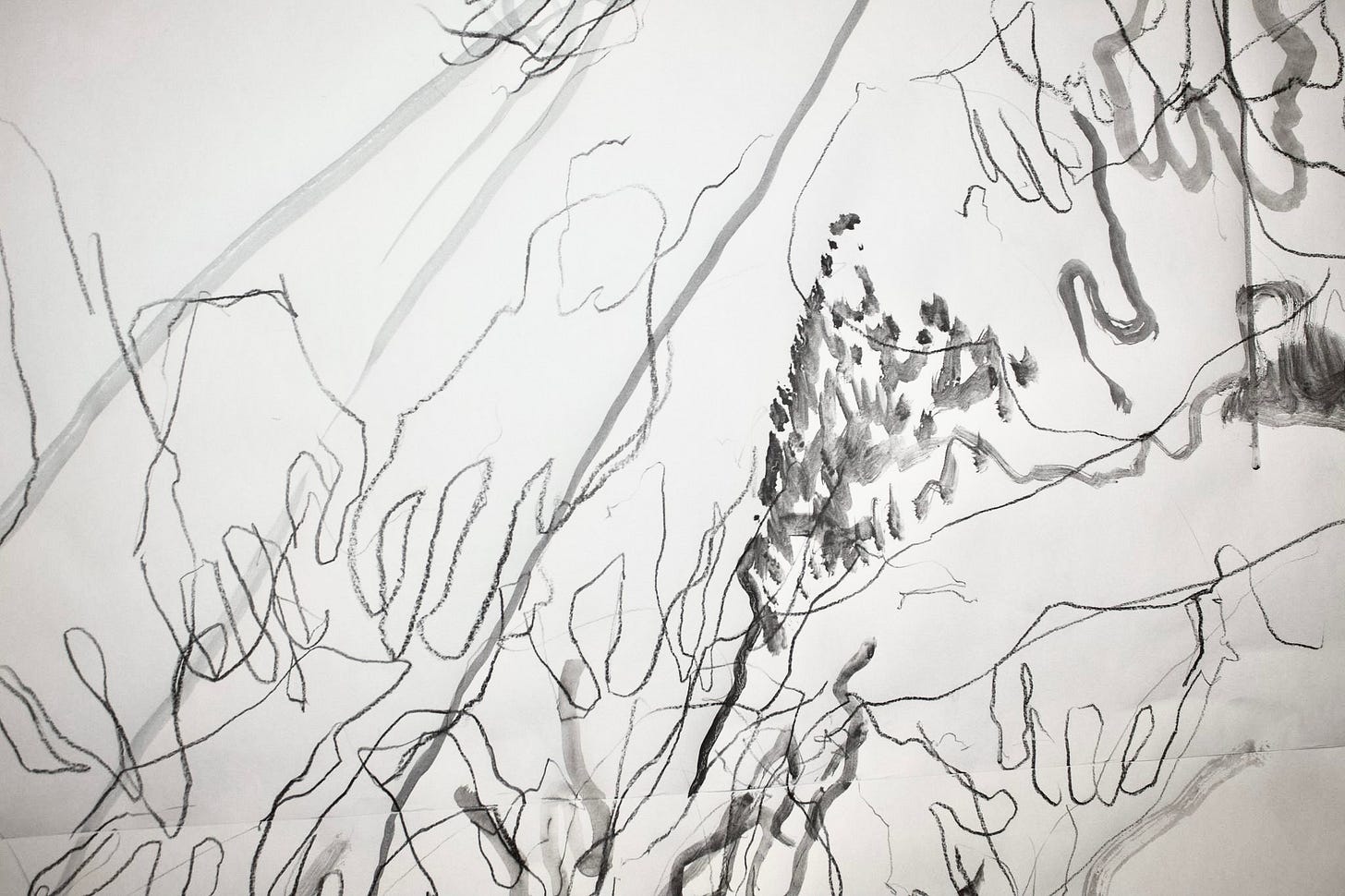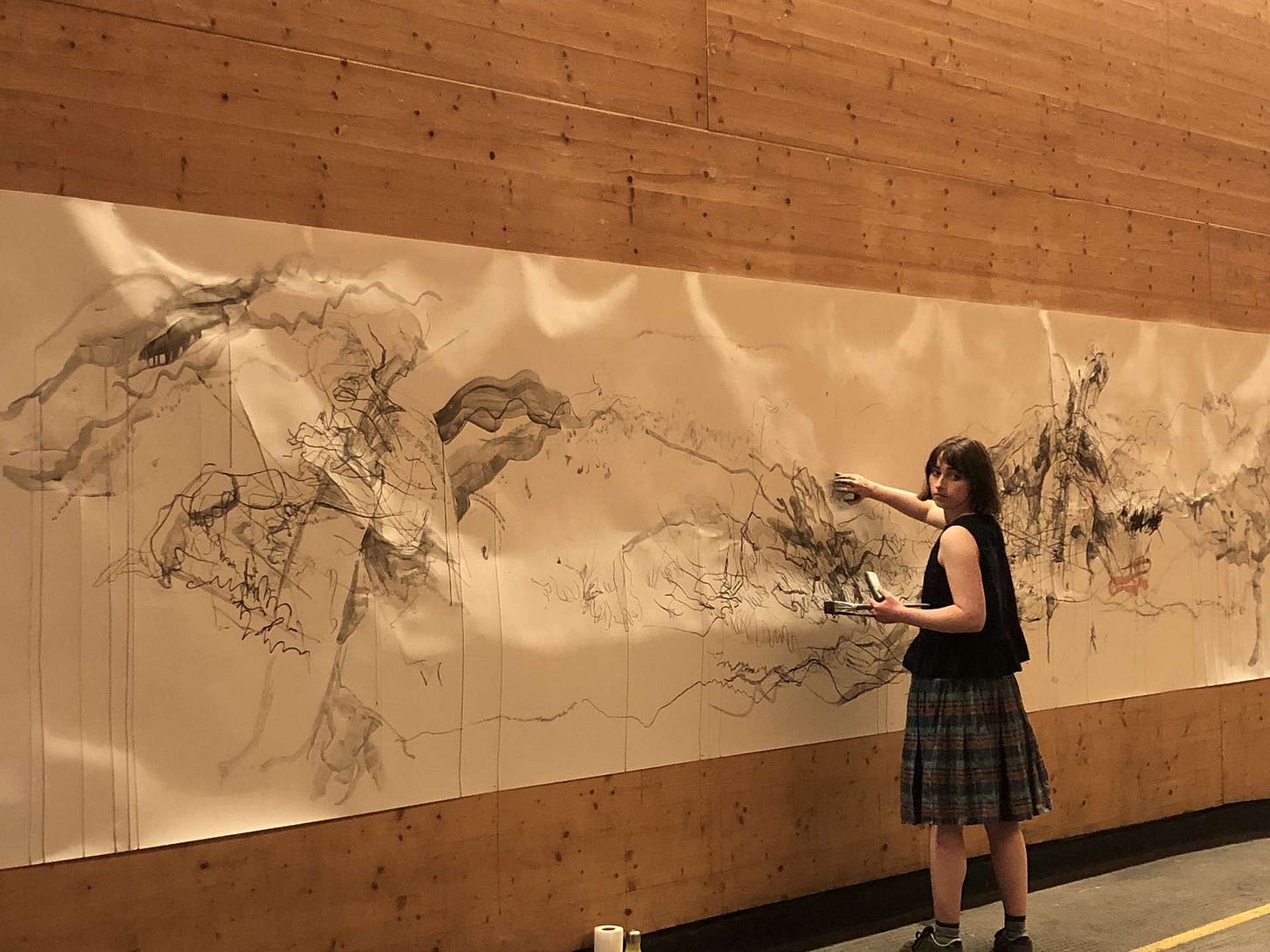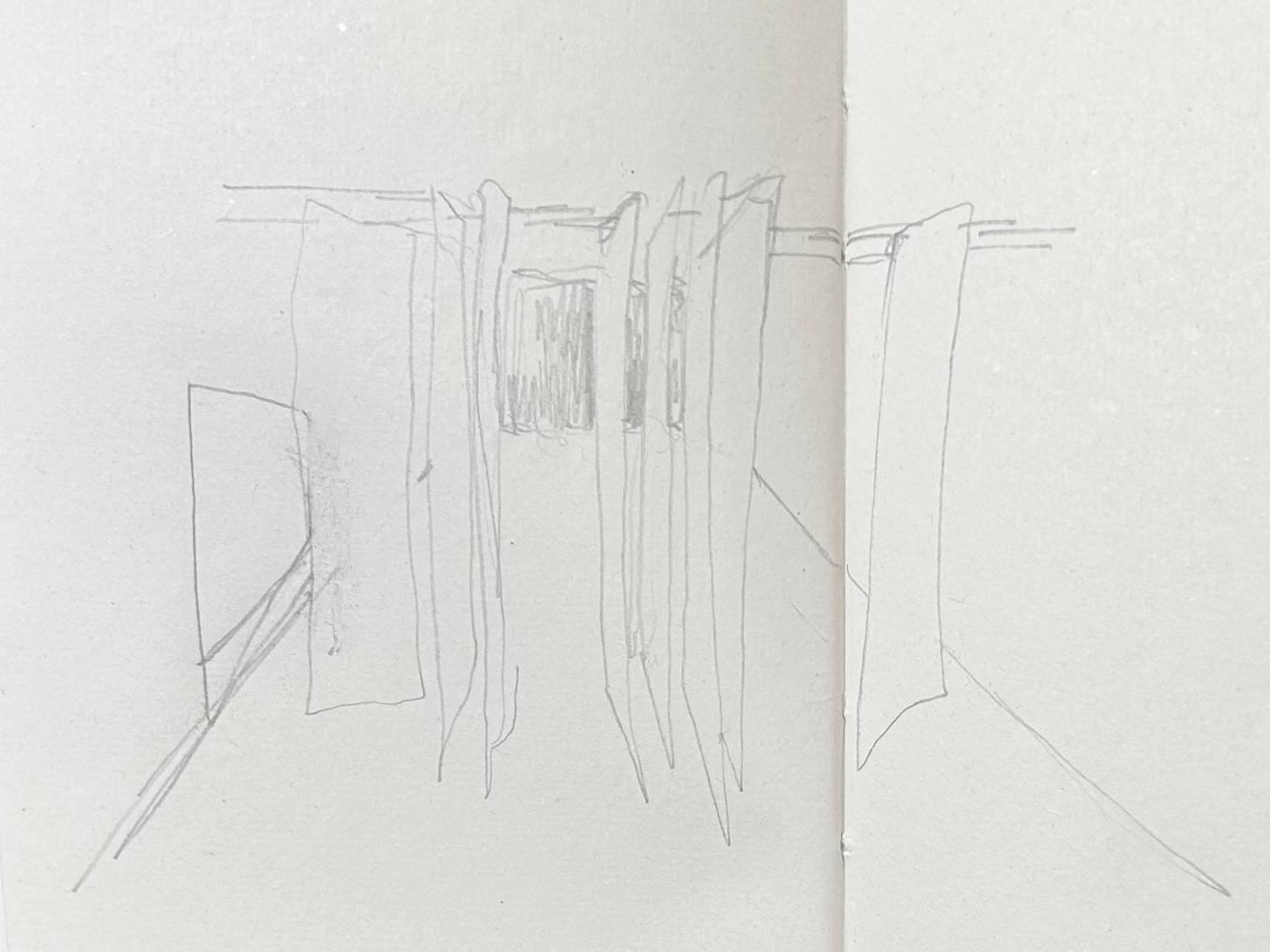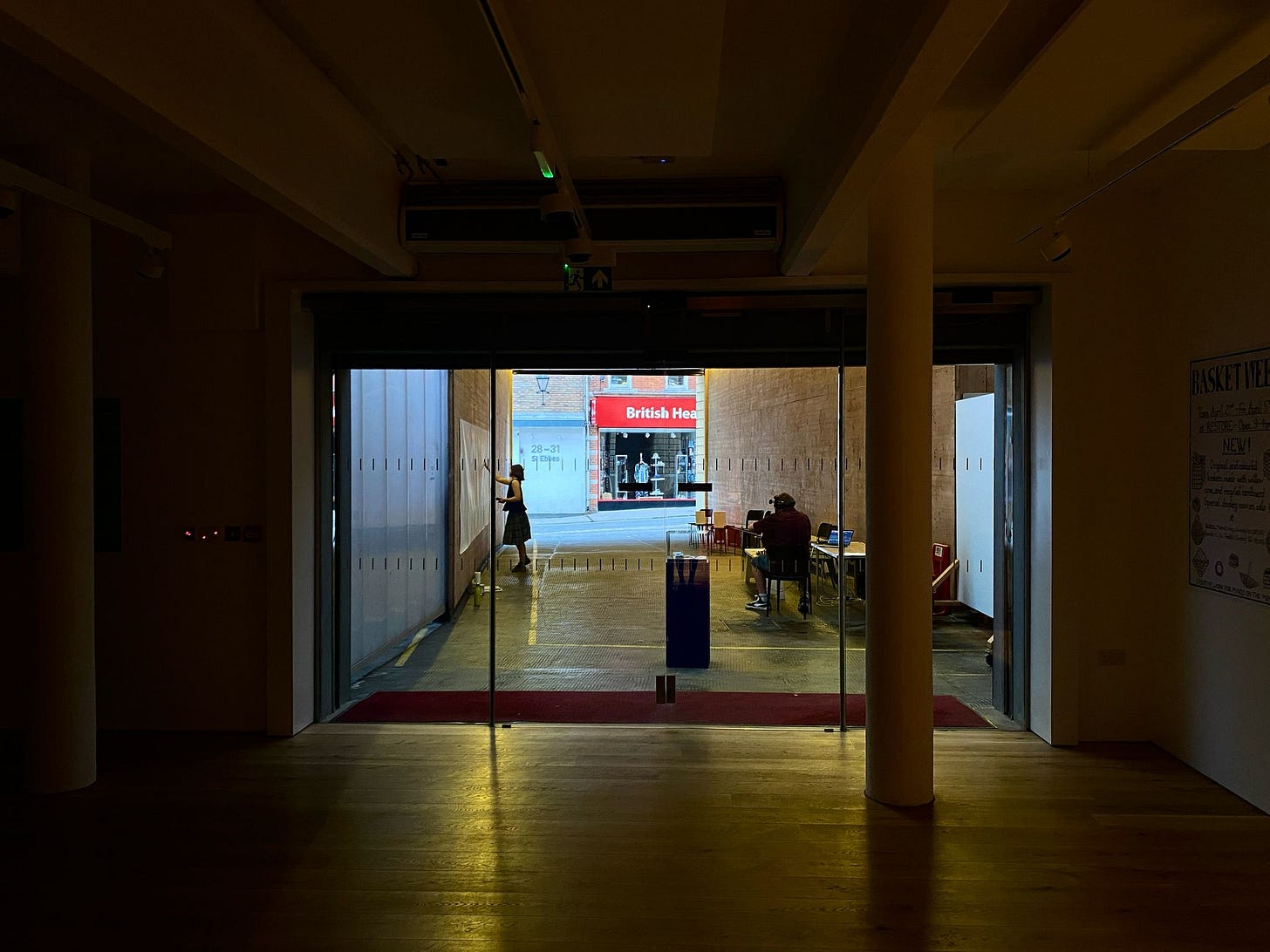Layers of Listening and Observing
Thoughts on TRANSLATIONS, performance collaboration
Although influenced by the people around me, most of the work I produce in the studios is made alone. I process ideas, thoughts and materials by myself. I am keen, however, to open my practice up and work with and alongside other creative people, especially from disciplines other than my own. Over the past few months, I’ve been collaborating with Matthew, a musician, to explore how we can learn from each other’s primary languages (his sound, mine mark) to influence our own. The collaboration has given us the opportunity to explore new stimuli through shared creative acts. We’ve developed ‘TRANSLATIONS,’ a live improvisation-based performance, in which we attempt to reflect our experience of the atmosphere of the space by reacting to sound through mark-making, and mark-making through sound. We invite the audience to help shape our performances by interacting with electronic equipment to affect the soundscape, and I record their part through my drawing.

When we began experimenting with this idea of a two-way improv, we were playing with ideas of iteration that stemmed from sound and marks only – I’d react to the sounds by making marks that felt appropriate, and Matthew would use my drawing as stimulus for the following section of music. I imagined this back-and-forth process would pull us into a spiralling, funnelling trajectory, at the end of which everything would converge. This never seemed to happen.
I think I had been disregarding how many other aspects of an environment influence our responses. We would have had to have been strict with ourselves, following unchanging mark-to-sound and sound-to-mark causal relationships for the piece to converge. Instead, during the two hour long performance, I think we’ve been reacting to sound and mark through the context of everything else that has been happening in the space: incidental sounds and marks interrupt the score; our energy levels wax and wane; we follow creative instincts to disrupt current patterns and throw something new into the mix. Inviting the audience to participate gave me permission to work my visual understanding of the environment into the piece, which felt like an important step. As a visual artist, while interesting to channel my focus on the soundscape as sole stimulus, it felt in some way disingenuous not to include in my drawing some reference to how my experience was impacted by the physicality of the gestures of Matthew playing the cello, or the collective hands of the public, which appeared almost choreographed to perform the same set of movements through the objects provided to them.

I’ve recently been thinking a lot about muslin cloths because of their translucency when singular and opacity when layered. During our most recent performance of ‘TRANSLATIONS,’ at Modern Art Oxford, I became intimately aware of the fact that I was drawing in time and space. I visualised sheets of muslin hanging through the space; layers between myself and Matthew and the people passing through. Layers of listening and observing, sheets overlapping to become cloudy where the sounds that I wasn’t listening to moved into the shadows, jade-like. In the space, I listened to the sounds from Matthew. I was conscious of the people in the space, trying to hear their comments and conversations. They’re trying to understand my marks and process to work out how they can control what I draw. I was aware of feeling a responsibility to either prove or disprove their understanding of my reactions by affirming them or ignoring them.
I singled out a hand from the audience. He had been sitting for half an hour, watching silently. He approached the controllers only when everyone else had left, and I could tell how carefully he was listening to the effects he was having on the soundscape. His hands reminded me of a family member’s, though I don’t know who. The gentleness with which he was taking part in the space, muslin sheets, hanging and moving. Some light let through, shadows catching on the sheets, lost through layers of white. Bamboo canes near the ceiling to hang from or stand together, on the floor of the Project Space. Near the window, little strands of string which become veins or vessels in the giant bunny’s bloody tummy.
Separations of space.
In moments like these I feel it is right for me to take control, to highlight this man, or to break away from my self-set rule of drawing the audience whenever they were interacting, to instead honour the sound and gestures of Matthew playing the cello. In other points, I feel a strange loss of control. Perhaps this is to do with a lack of experience of making work in front of an audience, and I should’ve had the confidence to control the timeline of the drawing more on my own terms. But whenever someone new was entering the space, I’d feel a duty to make a mark. With about 45 minutes until the scheduled end of the piece, I’d reached a point where if it had been my own drawing, I’d have stopped. I kept adding.
When Matthew and I performed at the Dolphin Gallery at St. John’s College, we reached a similar point just over an hour in. The improv students that we’d invited had been interacting with the controllers as we’d hoped, and I think they sensed this change of energy from us. They began introducing new sounds (paper sign dragged along the floor, water bottles crunching) and changing the atmosphere of the small room by turning the lights off and illuminating the drawing with phone torches and red flashing bike lights. Suddenly, there was new movement, new shadows. Matthew’s cello projected onto the paper as an upscaled silhouette.
Watching back the recording of our performance at Modern Art Oxford, I realise how different my experience of the space had been from Matthew’s. The phone recorded the sounds of objects being placed on the table and of his singing much more clearly than I could hear from my position. It reminded me of whale song, of being inside something and hearing the sounds through the object itself,
immersion.
A heartbeat inside the dark cupboard with 28 art students huddled together,
A pigeon’s coo reverberating under the train tracks, above the water’s surface where we crouched.
That internal sound is broken by the flap of wings.
Those white muslin sheets separate us until I choose to enter the space from somewhere else, the recording,
Shattering into fragments and becoming one again.







Thank-you for analysing your experience so clearly. It’s a fascinating read.
How beautiful! I can very much relate to the link with the world of music. Thank you for sharing so generously about the experience.